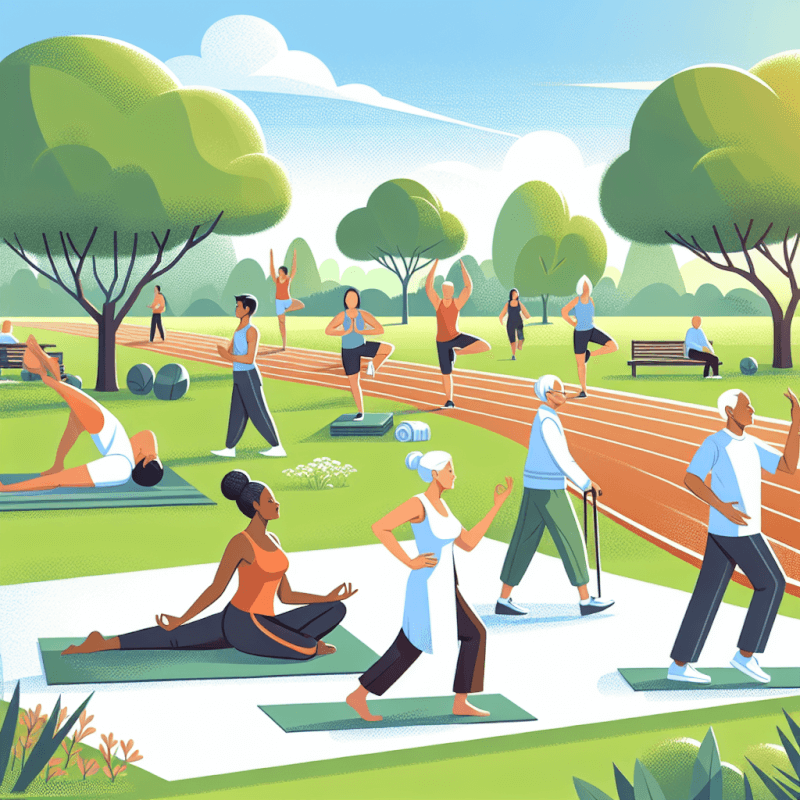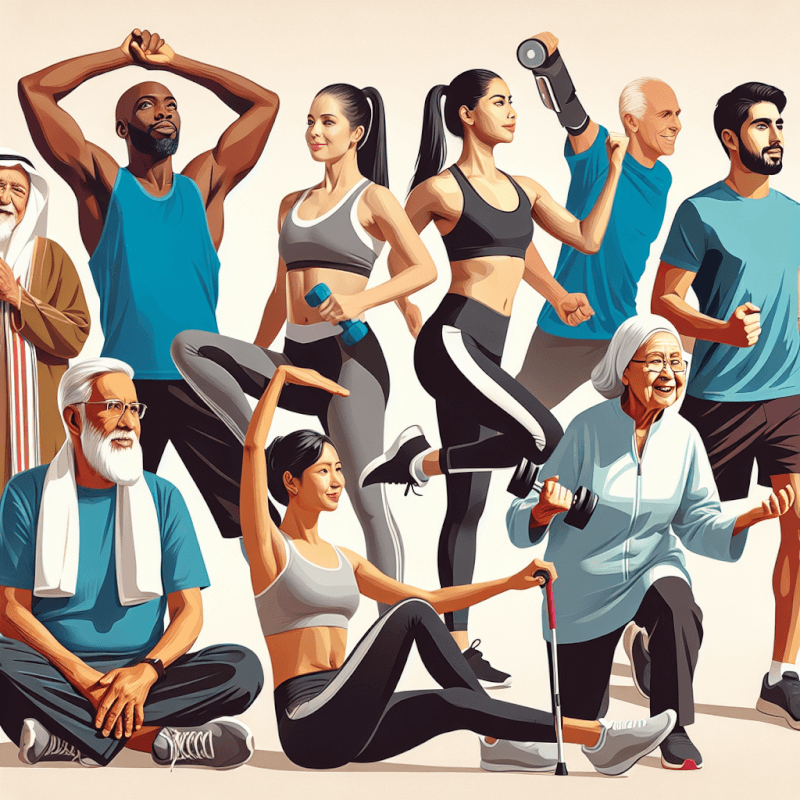Are you over 50 and looking to stay active and in shape? Look no further! This article gives you an overview of workouts specifically designed for individuals aged 50 and above. Whether you’re a fitness enthusiast or just starting your fitness journey, these workouts cater to all levels of fitness. From low-impact exercises to strength training routines, discover a variety of workouts that not only help you maintain a healthy lifestyle but also provide a fun and enjoyable experience. You’re never too old to prioritize your well-being, so let’s get started on your fitness journey today!

Cardiovascular Workouts
Walking
Walking is a fantastic cardiovascular workout that can be enjoyed by people of all ages, including those over 50. It’s a low-impact exercise that is gentle on the joints but still gets your heart rate up and your blood flowing. Whether you prefer a leisurely stroll or a brisk power walk, walking offers numerous health benefits. It helps improve cardiovascular fitness, reduces the risk of chronic diseases such as heart disease and diabetes, strengthens muscles and bones, and promotes overall well-being. So grab a comfortable pair of walking shoes, find a scenic route or a local park, and start enjoying the many benefits of walking!
Cycling
Cycling is another excellent cardiovascular workout option for individuals over 50. Whether you prefer riding a stationary bike at home or hitting the trails on a mountain bike, cycling offers a range of physical and mental health benefits. It’s a low-impact exercise that puts minimal stress on the joints but still provides a great cardiovascular workout. Cycling helps strengthen leg muscles, improve balance and coordination, boost endurance, and burn calories. Moreover, it can be a fun and enjoyable activity that allows you to explore the outdoors or enjoy the comfort of your own home while getting your heart pumping.
Swimming
Swimming is a highly recommended cardiovascular exercise for people of all ages, including those over 50. Being immersed in water provides a low-impact environment that alleviates pressure on the joints, making it ideal for individuals with arthritis or joint pain. Swimming engages the entire body, working all major muscle groups while providing an excellent cardiovascular workout. It helps improve lung capacity, build endurance, enhance flexibility, and promote heart health. Whether you choose to swim laps, take a water aerobics class, or even just play around in the pool, swimming offers a refreshing and enjoyable way to stay fit.
Aerobics
Aerobics is a classic cardiovascular workout that has been popular for decades, and it continues to be a great choice for individuals over 50. There are various types of aerobics classes available, ranging from high-impact to low-impact, allowing you to choose the intensity level that suits your fitness level and preferences. Aerobic exercises typically involve continuous rhythmic movements that increase your heart rate, boost oxygen consumption, and improve lung function. Benefits of aerobics include weight loss, increased energy levels, reduced risk of chronic diseases, improved cardiovascular fitness, and enhanced mood. So put on some comfortable workout clothes and join a local aerobics class to get your heart pumping!
Dancing
Dancing is not only a fun and enjoyable activity but also a fantastic way to get a cardiovascular workout. Whether you prefer ballroom dancing, Zumba, salsa, or hip hop, dancing provides a range of health benefits for individuals over 50. It improves cardiovascular fitness, enhances coordination and balance, strengthens muscles, and increases flexibility. Dancing is not only a great physical workout but also a wonderful way to boost your mood and relieve stress. So put on your dancing shoes, find a dance class or social event in your area, and let the music move you!
Strength Training
Bodyweight Exercises
Strength training is essential for individuals over 50 as it helps maintain muscle mass, improve bone density, and increase overall strength and stability. Bodyweight exercises are a perfect option for strength training without the need for additional equipment. Exercises such as push-ups, squats, lunges, planks, and burpees can all be done using your body weight as resistance. Bodyweight exercises are customizable to your fitness level, allowing you to progress at your own pace. They target multiple muscle groups simultaneously, helping improve overall functional fitness. Incorporating bodyweight exercises into your workout routine will help you stay strong and active as you age.
Resistance Band Workouts
Resistance bands are an excellent tool for strength training, especially for individuals over 50. They are lightweight, portable, and versatile, making them ideal for home workouts or when traveling. Resistance bands provide constant tension throughout the entire range of motion, helping build strength and muscle endurance. They come in various resistance levels, allowing you to adjust the intensity of your workouts. Resistance band exercises can target all major muscle groups, including the arms, legs, chest, back, and core. Whether you’re a beginner or more advanced, incorporating resistance band workouts into your routine can help you maintain muscle mass, improve balance, and increase overall strength.
Weightlifting
Weightlifting, or strength training with free weights and weight machines, is a highly effective way to build muscle and increase strength for individuals over 50. Contrary to common misconceptions, weightlifting is safe and beneficial for older adults, as long as proper form and technique are used. It helps maintain muscle mass, increases bone density, improves joint function, and boosts metabolism. Weightlifting exercises can be customized to target specific muscle groups, allowing you to address any imbalances or weaknesses. Whether you choose dumbbells, barbells, or weight machines, incorporating weightlifting into your fitness routine will help you maintain a strong and functional body.
Functional Training
Functional training focuses on improving strength, flexibility, and coordination specific to daily activities and movements. It helps individuals over 50 maintain independence and perform daily tasks with ease. Functional training exercises mimic real-life movements, such as squatting, lifting, pushing, and pulling, to improve overall functional fitness. It engages multiple muscle groups simultaneously, enhancing stability and balance. Exercises such as squats with overhead presses, medicine ball throws, farmer’s walks, and step-ups are examples of functional training exercises. By incorporating functional training into your routine, you can improve your ability to perform daily activities and reduce the risk of injury.
Pilates
Pilates is a low-impact strength training method that focuses on core stability, flexibility, and overall body strength. It is particularly beneficial for individuals over 50 as it improves posture, strengthens the core, and enhances overall body awareness. Pilates exercises emphasize controlled movements and proper alignment, helping improve balance, coordination, and muscle tone. It targets deep muscles that are often neglected in traditional strength training, which helps support the spine and prevent injuries. Whether you choose to practice Pilates mat exercises or use specialized equipment such as the reformer, incorporating Pilates into your fitness routine will help you develop a strong, balanced, and flexible body.
Flexibility and Stretching
Yoga
Yoga is an ancient practice that combines physical postures, breathing exercises, and meditation. It is a fantastic way to improve flexibility, balance, and strength while promoting relaxation and stress reduction. Yoga involves holding poses and flowing through sequences, which helps lengthen and stretch the muscles while improving joint range of motion. The practice of yoga also focuses on deep breathing, which enhances lung capacity and promotes a sense of calmness. Whether you’re a beginner or more advanced, there are various styles of yoga suitable for individuals over 50, such as Hatha, Vinyasa, and Yin yoga. Including yoga in your fitness routine will help you maintain flexibility, improve posture, and enhance your overall sense of well-being.
Tai Chi
Tai Chi is a Chinese martial art that combines slow, flowing movements with deep breathing and meditation. It is often referred to as “moving meditation” and is suitable for individuals of all ages, including those over 50. Tai Chi promotes balance, flexibility, and agility while cultivating mental clarity and relaxation. The slow and controlled movements in Tai Chi help improve joint mobility and enhance overall body awareness. Regular practice of Tai Chi has been shown to reduce the risk of falls, improve posture, and alleviate symptoms of chronic conditions such as arthritis and fibromyalgia. Consider joining a Tai Chi class or following instructional videos to experience the many benefits this mindful practice has to offer.
Pilates
As mentioned earlier, Pilates is not only a strength training method but also an excellent option for improving flexibility. Pilates exercises emphasize controlled movements and stretching, which helps lengthen and elongate the muscles. The full range of motion and focus on proper alignment in Pilates exercises promote flexibility and joint mobility. Whether it’s stretches targeting specific muscle groups or incorporating stretching into a full-body Pilates routine, Pilates can help improve flexibility and prevent muscle imbalances.
Dynamic Stretching
Dynamic stretching involves controlled movements that take your joints and muscles through their full range of motion. It is often used as a warm-up before physical activity to prepare the body for movement and prevent injury. Dynamic stretches differ from static stretches, as they involve continuous motion rather than holding a stretch for an extended period. Examples of dynamic stretches include walking lunges, arm circles, leg swings, and trunk rotations. Incorporating dynamic stretching into your fitness routine can improve flexibility, enhance athletic performance, and increase blood flow to the muscles.
Static Stretching
Static stretching involves holding a stretch for a prolonged period, typically around 30 seconds. It helps lengthen and relax the muscles, improves flexibility, and promotes overall relaxation. Static stretching is best performed after a workout when the muscles are warm and pliable. It targets specific muscle groups and is particularly effective for increasing flexibility in areas such as the hamstrings, calves, and shoulders. Examples of static stretches include toe touches, seated forward bends, standing quad stretches, and shoulder stretches. Make static stretching a regular part of your post-workout routine to improve and maintain flexibility.
Balance and Stability Exercises
Tai Chi
As mentioned earlier, Tai Chi is not only a great option for improving flexibility but also for enhancing balance and stability. The slow and controlled movements in Tai Chi help improve proprioception (awareness of body position) and promote better balance. The shifting of weight from one leg to another and the focus on maintaining proper alignment helps improve stability and coordination. Regular practice of Tai Chi can significantly reduce the risk of falls and improve balance control, making it an excellent choice for individuals over 50.
Yoga
Yoga is another practice that offers numerous benefits for balance and stability. Many yoga poses require balance and core strength, helping improve overall stability. Standing poses, such as Tree Pose and Warrior III, challenge your balance and engage the muscles in your legs and core. Balancing poses also help enhance focus and concentration, improving mind-body connection. By incorporating yoga into your fitness routine, you can develop better balance and stability while enjoying the mental and physical benefits of this ancient practice.
Balance Board Exercises
Balance board exercises involve standing or performing movements on a balance board, which challenges your balance and stability. The unstable surface of the balance board engages the smaller stabilizing muscles, improving overall balance control. Exercises on a balance board can range from basic static poses to dynamic movements such as squats, lunges, and push-ups. Using a balance board regularly can enhance proprioception, strengthen the muscles responsible for balance, and reduce the risk of falls or injuries. If you’re new to balance board exercises, start with simple static poses and gradually progress to more challenging movements.
Single-Leg Stands
Single-leg stands are simple yet effective exercises for improving balance and stability. Stand next to a wall or hold onto a stable surface for support if needed. Lift one leg off the ground and balance on the other leg for as long as you can comfortably maintain your balance. Start with 10-20 seconds and gradually work your way up to longer durations. As you become more confident and stable, you can add variations to the exercise, such as closing your eyes or performing small leg movements. Single-leg stands can be done anywhere, anytime, and they are a convenient way to strengthen the muscles responsible for balance.
Bosu Ball Workouts
A Bosu ball is a versatile piece of equipment that can be used to improve balance, stability, and core strength. It consists of a semi-spherical ball attached to a flat platform, providing an unstable surface for exercises. Bosu ball workouts engage the core muscles, as well as the muscles in the legs and hips that help maintain stability. Exercises can include squats, lunges, single-leg stands, and planks performed on the Bosu ball. The unstable surface of the Bosu ball challenges your balance and forces your muscles to work harder. Incorporating Bosu ball exercises into your routine will help improve balance, stability, and overall body strength.

Low Impact Workouts
Swimming
As previously mentioned, swimming is an excellent low-impact workout that is gentle on the joints and ideal for individuals over 50. The buoyancy of the water reduces the impact on your body while providing resistance for a full-body workout. Swimming engages all major muscle groups, improves cardiovascular fitness, and promotes overall strength and endurance. The water also provides a cooling effect, making swimming a great option for individuals who may be sensitive to high-impact exercises or who live in hot climates. Whether you swim laps or participate in water aerobics classes, swimming offers a refreshing and joint-friendly workout.
Water Aerobics
Water aerobics is a low-impact workout that takes place in shallow water or a pool. It combines aerobic exercises with resistance training, making it a complete and gentle workout for individuals over 50. The buoyancy of the water reduces stress on the joints, making water aerobics suitable for individuals with arthritis or joint pain. Water aerobics exercises typically involve walking or running in the water, performing jumping jacks, kicks, or arm movements, and using water weights or resistance bands for added resistance. The water provides resistance in all directions, making every movement engaging and effective. Joining a water aerobics class or following instructional videos is a great way to get started with this low-impact workout option.
Elliptical Trainer
The elliptical trainer is a low-impact cardio machine that provides a full-body workout while minimizing stress on the joints. It mimics the natural motion of walking, jogging, or running but with less impact on the knees, hips, and ankles. The elliptical trainer also incorporates arm handles, which engage the upper body and provide an effective cardiovascular workout. Many elliptical machines offer adjustable resistance and incline levels, allowing you to customize the intensity of your workout. Whether you choose to use an elliptical machine at the gym or invest in one for home use, it’s an excellent option for low-impact cardio that still gets your heart rate up and burns calories.
Recumbent Bike
The recumbent bike is another low-impact cardio machine that is gentle on the joints and great for individuals over 50. It provides a comfortable and supportive workout, as you sit in a reclined position with your legs extended in front of you. The recumbent bike offers similar cardiovascular benefits to a traditional bike but with less strain on the back, hips, and knees. It helps improve cardiovascular fitness, build leg strength, and burn calories. Many recumbent bikes have adjustable resistance levels, allowing you to tailor the intensity of your workout. Whether you use a recumbent bike at the gym or invest in one for home use, it’s a fantastic option for low-impact cardio that can be enjoyed by individuals of all fitness levels.
Yoga
As mentioned earlier, yoga is not only a mind-body workout but also a low-impact exercise option. The gentle and controlled movements in yoga help improve flexibility, strengthen muscles, and promote relaxation. Yoga poses can be modified to suit your needs and fitness level, making it accessible for individuals over 50. The slow-paced nature of yoga allows you to listen to your body, breathe deeply, and move within your comfort zone. Whether you practice gentle Hatha yoga or opt for a restorative and relaxing Yin yoga class, yoga offers a low-impact workout that benefits both the body and the mind.
High-Intensity Interval Training (HIIT)
HIIT Workouts for Beginners
High-Intensity Interval Training (HIIT) involves short bursts of intense exercise followed by short recovery periods. It’s a time-efficient workout method that offers numerous health benefits, including improved cardiovascular fitness, increased metabolism, and enhanced fat burning. If you’re new to HIIT or have any underlying health conditions, it’s important to start with beginner-friendly workouts to ensure your safety.
A beginner HIIT workout could involve exercises such as jumping jacks, high knees, mountain climbers, and bodyweight squats. You would perform each exercise at maximum effort for a set amount of time, such as 30 seconds, and then rest for a shorter recovery period, such as 15 seconds. The workout would typically consist of several rounds of these intervals, gradually building up your stamina and intensity levels as you become more comfortable. Remember to listen to your body and modify the exercises or the work-to-rest ratio to suit your fitness level.
HIIT Workouts with Modifications
HIIT workouts can be modified to accommodate individuals with various fitness levels or physical limitations. If you have joint issues or struggle with high-impact exercises, there are plenty of low-impact alternatives that can still raise your heart rate and provide an effective HIIT workout.
For example, instead of jumping jacks, you can perform side steps or step touches. Instead of high knees, you can do marching in place or knee lifts. These modifications reduce the impact on your joints while still challenging your cardiovascular system and engaging your muscles. HIIT workouts can also be adapted to include equipment such as resistance bands, dumbbells, or kettlebells to increase the intensity without relying on high-impact movements. Experiment with different modifications and find what works best for you to enjoy the benefits of a high-intensity workout while protecting your joints and accommodating your fitness level.
HIIT Circuit Training
HIIT circuit training involves moving through a sequence of exercises with little to no rest in between. It’s a highly effective way to combine strength and cardiovascular training into one challenging workout. HIIT circuit training allows you to target different muscle groups while keeping your heart rate elevated, maximizing calorie burn and improving overall fitness.
An example of a HIIT circuit workout could be a series of exercises such as push-ups, squats, lunges, mountain climbers, and planks. Perform each exercise for a designated period, such as 30 seconds, and move on to the next exercise without resting. Complete the entire circuit and then rest for a short period before repeating the circuit for multiple rounds. The intensity and duration of the workout can be adjusted to suit your fitness level and goals. HIIT circuit training is a time-efficient way to get an effective full-body workout and boost your metabolism.
Tabata Training
Tabata training is a specific form of HIIT that involves 20 seconds of all-out effort followed by 10 seconds of rest, repeated for eight rounds. This protocol was developed by Japanese researcher Dr. Izumi Tabata and has been shown to significantly increase aerobic and anaerobic fitness.
Tabata workouts can be customized to include various exercises, such as burpees, squat jumps, cycling sprints, or kettlebell swings. Each exercise is performed at maximum effort for 20 seconds, followed by 10 seconds of rest, and then repeated for a total of four minutes. Tabata training is intense and efficient, providing a highly effective cardiovascular and muscular workout in a short amount of time.
HIIT on Cardio Machines
Many traditional cardio machines, such as treadmills, stationary bikes, and rowing machines, offer pre-programmed HIIT workouts that you can easily incorporate into your exercise routine. These workouts typically involve alternating between periods of high-speed or high-resistance intervals and active recovery periods.
For example, on a treadmill, you could sprint at a challenging pace for 30 seconds, followed by a slower-paced recovery period for 60 seconds. This pattern would be repeated for several rounds, gradually increasing the intensity as your fitness level improves. The same concept can be applied to other cardio machines, adjusting the resistance or speed settings according to your capabilities.
HIIT on cardio machines is a convenient and efficient way to get your heart rate up and challenge yourself, as the machines provide controlled environments for varying intensity levels. However, always listen to your body and adjust the settings to a level that is safe and comfortable for you.

Group Fitness Classes
Zumba
Zumba is a high-energy dance fitness class that combines Latin and international music with fun and easy-to-follow dance moves. It’s a group fitness class suitable for individuals of all fitness levels, including those over 50. Zumba classes provide a cardio workout that can improve cardiovascular fitness, enhance coordination, burn calories, and boost mood. The upbeat music and party-like atmosphere make Zumba classes enjoyable and motivating. Whether you’re a seasoned dancer or new to the world of dance fitness, Zumba is a fantastic way to get moving, have fun, and connect with others.
Pilates
As previously mentioned, Pilates is a versatile workout method that offers various benefits, including strength training, flexibility, and balance. Pilates classes are often conducted in a group setting, allowing individuals over 50 to enjoy the social aspect of exercising while reaping the physical benefits of this mind-body workout. Pilates classes typically include a series of exercises performed on a mat or specialized equipment, focusing on core strength, stability, and body awareness. With the guidance of a qualified instructor, you can develop proper form, improve posture, and challenge yourself at your own pace within a supportive group environment.
Yoga
Yoga classes are a popular choice for individuals of all ages and fitness levels, including those over 50. Whether you attend a gentle Hatha yoga class, a more dynamic Vinyasa flow class, or a restorative Yin yoga class, yoga offers a variety of styles to suit your needs and preferences. Yoga classes typically include a combination of physical postures, breathing exercises, and meditation. They help improve flexibility, strength, balance, and overall well-being. Attending yoga classes provides the opportunity to learn from experienced instructors, connect with like-minded individuals, and deepen your practice in a supportive and non-competitive atmosphere.
Aqua Aerobics
Aqua aerobics, also known as water aerobics, is a group fitness class that takes place in a pool or shallow water. It combines aerobic exercises, resistance training, and stretching in a low-impact environment. Aqua aerobics classes offer a gentle yet effective workout for individuals over 50, as the water provides buoyancy and reduces stress on the joints. The resistance of the water also adds an extra challenge to the exercises, making them more engaging and increasing muscle toning benefits. Joining an aqua aerobics class allows you to socialize, cool off, and improve your overall fitness in a fun and supportive environment.
Spin Classes
Spin classes, also known as indoor cycling classes, are high-energy workouts that take place on specialized stationary bikes. They are typically led by an instructor who guides participants through a series of cycling routines set to energizing music. Spin classes provide a challenging cardiovascular workout that can be tailored to your fitness level by adjusting the resistance and speed settings on the bike. They improve cardiovascular fitness, strengthen leg muscles, and burn calories. Spin classes offer a motivating and energizing group atmosphere where you can push yourself, enjoy the camaraderie of fellow participants, and reap the many benefits of this intense yet low-impact workout.
Functional Fitness Workouts
Martial Arts
Martial arts, such as karate, taekwondo, or judo, offer a unique combination of physical fitness, self-defense skills, discipline, and mental focus. These ancient disciplines can be practiced by individuals of all ages and provide a variety of health benefits for individuals over 50. Martial arts training typically involves a combination of punches, kicks, blocks, and flexibility exercises. It helps improve cardiovascular fitness, build strength and endurance, enhance flexibility, and improve coordination and balance. Additionally, martial arts training promotes mental well-being through stress reduction, increased self-confidence, and improved concentration. Whether you’re a beginner or have previous experience, martial arts can be a fantastic way to stay active and cultivate a sense of discipline and personal growth.
CrossFit
CrossFit is a popular strength and conditioning program that incorporates high-intensity functional movements performed at a fast pace. It focuses on building overall fitness by combining elements of weightlifting, cardio, and bodyweight exercises. CrossFit workouts are typically performed in a group setting, offering a supportive and motivating environment. While CrossFit’s intensity level can be challenging, workouts can be modified to suit your individual fitness level and abilities. CrossFit improves strength, power, endurance, and flexibility, making it a comprehensive approach to functional fitness. Joining a CrossFit gym and working with certified coaches can ensure proper technique and appropriate progression within this dynamic and engaging training method.
TRX Training
TRX training utilizes specialized suspension straps that leverage gravity and bodyweight to perform a wide range of exercises. It is a highly versatile workout method that targets multiple muscle groups simultaneously while challenging core stability and balance. TRX training is suitable for individuals over 50 as it can be adapted to various fitness levels and provides a low-impact option for strength and functional training. The adjustable straps allow for modifications and variations, making TRX training accessible for beginners and more challenging for advanced users. TRX exercises can improve strength, stability, flexibility, and overall body control. Whether you choose to join a TRX class or incorporate TRX exercises into your home or gym routine, you’ll benefit from this engaging and effective workout method.
Parkour
Parkour is a discipline that involves using movement to overcome obstacles and navigate urban environments efficiently. While it may seem extreme, parkour can be adapted for individuals of all fitness levels and interests. Parkour training often involves running, jumping, climbing, crawling, and vaulting, which can boost cardiovascular fitness, strength, agility, and mobility. Parkour is not limited to outdoor settings, as there are numerous indoor facilities designed specifically for parkour practice. Parkour training offers physical challenges while fostering mental resilience, creativity, and problem-solving skills. It’s an unconventional and stimulating workout option for individuals over 50 who seek to break free from traditional fitness routines and embrace a more dynamic and adventurous approach.
Obstacle Course Training
Obstacle course training involves completing various physical challenges that mimic obstacles found in races such as Spartan Race, Tough Mudder, or Warrior Dash. These courses often include running or hiking, climbing walls, crawling under nets, traversing monkey bars, and carrying heavy objects. Obstacle course training offers a unique combination of cardiovascular conditioning, strength training, and mental toughness. It’s a fun and functional workout that tests your physical limits while building overall fitness and resilience. Obstacle course races can be completed individually or in teams, providing a supportive and encouraging environment for individuals over 50 to challenge themselves and celebrate their achievements.

Mind-Body Workouts
Yoga
As mentioned earlier, yoga is not only a physical exercise but also a mind-body practice. It incorporates conscious breathing, mindfulness, and meditation techniques to enhance mental well-being and overall relaxation. Yoga postures, known as asanas, are performed with focused attention to body alignment and breath awareness. The combination of physical movement and breath control helps reduce stress, improve concentration, and promote inner balance. Yoga is a holistic practice that benefits both the body and the mind, making it an ideal workout for individuals over 50 who seek to integrate physical fitness with mental and emotional well-being.
Meditation
Meditation is a practice that involves training the mind to focus and redirect thoughts, leading to a state of mental clarity and emotional calmness. It can be done in various ways, such as sitting quietly and observing the breath, repeating a mantra, or engaging in guided visualization. Meditation has numerous health benefits, including stress reduction, improved emotional well-being, enhanced self-awareness, and increased attention span. Regular meditation practice can also improve sleep quality and reduce symptoms of anxiety and depression. Whether you prefer to meditate in a quiet space at home, join a group meditation class, or use meditation apps or online resources, incorporating meditation into your daily routine can bring a sense of peace and balance to your life.
Pilates
Pilates, as mentioned earlier, is not only a physical workout but also a practice that promotes body awareness, mindfulness, and connection between the mind and body. The controlled and precise movements in Pilates require concentration, focus, and breath control, fostering a meditative state of mind. Practicing Pilates mindfully can help relieve stress, improve mental clarity, and enhance body-mind connection. The mind-body aspect of Pilates sets it apart from other forms of exercise and makes it a valuable tool for individuals over 50 who seek to cultivate overall well-being and a sense of inner calm.
Tai Chi
Tai Chi, as mentioned earlier, combines slow, flowing movements with deep breathing and meditation. It is known as “moving meditation” and offers numerous benefits for both the body and the mind. Tai Chi practice involves mindful attention to body movements, breath control, and mental focus. The slow and controlled nature of Tai Chi helps relax the mind, reduce stress, and promote mental clarity. Regular practice of Tai Chi can improve body awareness, increase energy levels, and enhance overall well-being. Whether you join a Tai Chi class, follow instructional videos, or practice outdoors in a peaceful setting, Tai Chi is a mindful workout option for individuals over 50 looking to achieve physical and mental harmony.
Qi Gong
Qi Gong, pronounced “chee gong,” is a Chinese practice that combines movement, deep breathing, and meditation to cultivate and balance the body’s vital energy. It is similar to Tai Chi in its slow and flowing movements but focuses more on energy cultivation and self-healing. Qi Gong practice involves gentle movements that harmonize with breath control and visualization. It aims to improve the flow of energy, or “qi,” throughout the body, promoting health, vitality, and balance. Qi Gong is accessible to individuals of all fitness levels and can be practiced indoors or outdoors. Incorporating Qi Gong into your fitness routine can help reduce stress, increase relaxation, and enhance overall well-being.
Outdoor Exercise Options
Hiking
Hiking is a fantastic outdoor exercise option for individuals over 50 who enjoy being in nature and exploring new trails. It offers numerous health benefits, including cardiovascular fitness, improved muscle strength, enhanced bone density, and reduced stress levels. Hiking engages the entire body, including the legs, core, and upper body, as you navigate various terrains and elevations. Moreover, hiking provides an opportunity to connect with nature, enjoy beautiful scenery, and experience the mental and emotional benefits of spending time outdoors. Whether you prefer hiking on easy trails or tackling more challenging routes, make sure to wear appropriate footwear, bring plenty of water, and start with trails that match your fitness level.
Cycling
Cycling isn’t limited to indoor stationary bikes – outdoor cycling offers an enjoyable and scenic workout option for individuals over 50. Whether you choose a road bike, a mountain bike, or an electric bike, cycling allows you to explore your local area, enjoy fresh air, and embrace the freedom of being on two wheels. Cycling is a low-impact exercise that improves cardiovascular fitness, strengthens leg muscles, and enhances joint mobility. It’s a versatile activity that can be tailored to your fitness level and preferences, whether you prefer leisurely bike rides or more challenging routes. Just remember to wear a helmet, obey traffic rules, and choose cycling routes that are safe and suitable for your abilities.
Kayaking
Kayaking provides an excellent opportunity to enjoy the tranquility of water while getting a full-body workout. Whether you prefer kayaking on lakes, rivers, or coastal areas, it offers a low-impact and immersive exercise experience for individuals over 50. Kayaking engages the muscles in your arms, shoulders, back, and core, as you paddle and navigate the water. It also provides cardiovascular benefits and enhances balance and coordination. Kayaking allows you to explore hidden coves, observe wildlife, and enjoy the serenity of being on the water. Whether you’re a beginner or have experience, kayaking can be a fun and rewarding outdoor activity that keeps you active and connected to nature.
Gardening
Gardening may not seem like traditional exercise, but it offers a range of physical activity and mental health benefits for individuals over 50. Tasks such as planting, weeding, watering, and digging require bending, reaching, lifting, and repetitive movements, engaging various muscle groups and promoting flexibility and strength. Gardening also provides an opportunity to enjoy fresh air, connect with nature, and reduce stress levels. Spending time in the garden has been shown to promote physical health, improve mood, increase vitamin D levels, and enhance overall well-being. Whether you have a small plot of land or a few pots on a balcony, gardening can be a rewarding and therapeutic outdoor activity that keeps you active and connected with the natural world.
Golf
Golf is a popular outdoor sport enjoyed by individuals of all ages, including those over 50. It offers a combination of physical activity, mental focus, and social interaction. Playing golf involves walking or using a golf cart to navigate the course, swinging the clubs to hit the ball, and strategizing to complete each hole. Golf provides a low-impact cardiovascular workout, strengthens core muscles, improves balance and coordination, and enhances mental agility. It offers an opportunity to spend time outdoors, enjoy beautiful landscapes, and connect with friends or fellow golf enthusiasts. Whether you’re a seasoned golfer or trying it for the first time, golf is a leisurely yet challenging outdoor activity that can be enjoyed for a lifetime.



